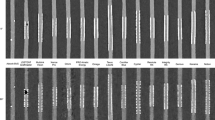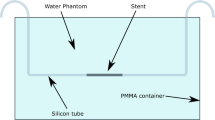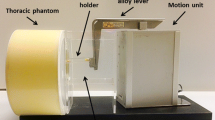Abstract
The purpose of this study was to test a large sample of different coronary artery stents using four image reconstruction approaches with respect to lumen visualization, lumen attenuation, and image noise in 64-slice multidetector-row computed tomography (MDCT) in vitro and to provide a catalogue of currently used coronary artery stents when imaged with state-of the-art MDCT. We examined 68 different coronary artery stents (57 stainless steel, four cobalt-chromium, one cobalt-alloy, two nitinol, four tantalum) in a coronary artery phantom (vessel diameter 3 mm, intravascular attenuation 250 HU, extravascular density −70). Stents were imaged in axial orientation with standard parameters: 32x0.6 collimation, pitch 0.24, 680 mAs, 120 kV, rotation time 0.37 s. Four different image reconstructions were obtained with varying convolution kernels and section thicknesses: (1) soft, 0.6 mm, (2) soft, 0.75, (3) medium soft, 0.6, and (4) stent-optimized sharp, 0.6. To evaluate visualization characteristics of of the stent, the lumen diameter, intraluminal density and noise were measured. The high-resolution kernel offered significantly better average lumen visualization (57% ±10%) and more realistic lumen attenuation (222 HU ±66 HU) at the expense of increased noise (15.3 HU ±3.7 HU) compared with the soft and medium-soft CT angiography (CTA) protocol (p<0.001 for all). Stents with a lumen visibility of more than 66% were: Arthos pico, Driver, Flex, Nexus2, S7, Tenax complete, Vision (all 67%), Symbiot, Teneo (70%), and Radius (73%). Only ten stents showed a lumen visibility of less than 50%. Stent lumen visibility largely varies depending on the stent type. Even with the improved spatial resolution of 64-slice CT, a stent-optimized kernel remains beneficial for stent visualization when compared with the standard medium-soft CTA protocol. Using 64-slice CT and high-resolution kernel, the majority of stent products show a lumen visibility of more than 50% of the stent diameter.


Similar content being viewed by others
References
American Heart Association (2005) Heart Disease and Stroke Statistics - 2005 Update
Scanlon PJ, Faxon DP, Audet AM, Carabello B, Dehmer GJ, Eagle KA, et al.(1999) ACC/AHA guidelines for coronary angiography. A report of the American College of Cardiology/American Heart Association Task Force on practice guidelines (Committee on Coronary Angiography). Developed in collaboration with the Society for Cardiac Angiography and Interventions. J Am Coll Cardiol 33(6):1756–1824
Maintz D, Botnar RM, Fischbach R, Heindel W, Manning WJ, Stuber M (2002) Coronary magnetic resonance angiography for assessment of the stent lumen: a phantom study. J Cardiovasc Magn Reson 4(3):359–367
Mohlenkamp S, Pump H, Baumgart D, Haude M, Gronemeyer DH, Seibel RM, et al (1999) Minimally invasive evaluation of coronary stents with electron beam computed tomography: In vivo and in vitro experience. Catheter Cardiovasc Interv 48(1):39–47
Pump H, Moehlenkamp S, Sehnert C, Schimpf SS, Erbel R, Seibel RM, et al (1998) Electron-beam CT in the noninvasive assessment of coronary stent patency. Acad Radiol 5(12):858–862
Maintz D, Grude M, Fallenberg EM, Heindel W, Fischbach R (2003) Assessment of coronary arterial stents by multislice-CT angiography. Acta Radiol 44(6):597–603
Kruger S, Mahnken AH, Sinha AM, Borghans A, Dedden K, Hoffmann R, et al (2003) Multislice spiral computed tomography for the detection of coronary stent restenosis and patency. Int J Cardiol 89(2–3):167–172
Ligabue G, Rossi R, Ratti C, Favali M, Modena MG, Romagnoli R (2004) Noninvasive evaluation of coronary artery stents patency after PTCA: role of Multislice Computed Tomography. Radiol Med (Torino) 108(1–2):128–137
Mahnken AH, Buecker A, Wildberger JE, Ruebben A, Stanzel S, Vogt F, et al (2004) Coronary artery stents in multislice computed tomography: in vitro artifact evaluation. Invest Radiol 39(1):27–33
Maintz D, Seifarth H, Flohr T, Kramer S, Wichter T, Heindel W, et al (2003) Improved coronary artery stent visualization and in-stent stenosis detection using 16-slice computed-tomography and dedicated image reconstruction technique. Invest Radiol 38(12):790–795
Schuijf JD, Bax JJ, Jukema JW, Lamb HJ, Warda HM, Vliegen HW, et al (2004) Feasibility of assessment of coronary stent patency using 16-slice computed tomography. Am J Cardiol 94(4):427–430
Seifarth H, Raupach R, Schaller S, Fallenberg EM, Flohr T, Heindel W, et al (2005) Assessment of coronary artery stents using 16-slice MDCT angiography: evaluation of a dedicated reconstruction kernel and a noise reduction filter. Eur Radiol 15(4):721–726
Hong C, Chrysant GS, Woodard PK, Bae KT (2004) Coronary artery stent patency assessed with in-stent contrast enhancement measured at multi-detector row CT angiography: initial experience. Radiology 233(1):286–291
Gilard M, Cornily JC, Rioufol G, Finet G, Pennec PY, Mansourati J, et al (2005) Noninvasive assessment of left main coronary stent patency with 16-slice computed tomography. Am J Cardiol 95(1):110–112
Flohr T, Stierstorfer K, Raupach R, Ulzheimer S, Bruder H (2004) Performance of a 64-slice CT system with z-flying focal spot. Rofo 176(12):1803–1810
Knollmann FD, Moller J, Gebert A, Bethge C, Felix R (2004) Assessment of coronary artery stent patency by electron-beam CT. Eur Radiol 14(8):1341–1347 Aug
Maintz D, Juergens KU, Wichter T, Grude M, Heindel W, Fischbach R (2003) Imaging of coronary artery stents using multislice computed tomography: in vitro evaluation. Eur Radiol 13(4):830–835
Kim WY, Danias PG, Stuber M, Flamm SD, Plein S, Nagel E, et al (2001) Coronary magnetic resonance angiography for the detection of coronary stenoses. N Engl J Med 345(26):1863–1869
Sommer T, Hofer U, Hackenbroch M, Meyer C, Flacke S, Schmiedel A, Schmitz C, Thiemann K, Omran H, Schild H (2002) Submillimeter 3D coronary MR angiography with real-time navigator correction in 107 patients with suspected coronary artery disease. Rofo 174(4):459–466
Sardanelli F, Zandrino F, Molinari G, Iozzelli A, Balbi M, Barsotti A (2002) MR evaluation of coronary stents with navigator echo and breath-hold cine gradient-echo techniques. Eur Radiol 12(1):193–200
Hug J, Nagel E, Bornstedt A, Schnackenburg B, Oswald H, Fleck E (2000) Coronary arterial stents: safety and artifacts during MR imaging. Radiology 216(3):781–787
Buecker A, Spuentrup E, Ruebben A, Gunther RW (2002) Artifact-free in-stent lumen visualization by standard magnetic resonance angiography using a new metallic magnetic resonance imaging stent. Circulation 105:1772–1775
Mahnken AH, Seyfarth T, Flohr T, Herzog C, Stahl J, Stanzel S, et al (2005) Flat-panel detector computed tomography for the assessment of coronary artery stents: phantom study in comparison with 16-slice spiral computed tomography. Invest Radiol 40(1):8–13
Acknowledgements
The authors would like to thank all companies that provided stents for the in vitro evaluations and information about their products.
Author information
Authors and Affiliations
Corresponding author
Rights and permissions
About this article
Cite this article
Maintz, D., Seifarth, H., Raupach, R. et al. 64-slice multidetector coronary CT angiography: in vitro evaluation of 68 different stents. Eur Radiol 16, 818–826 (2006). https://doi.org/10.1007/s00330-005-0062-8
Received:
Revised:
Accepted:
Published:
Issue Date:
DOI: https://doi.org/10.1007/s00330-005-0062-8




